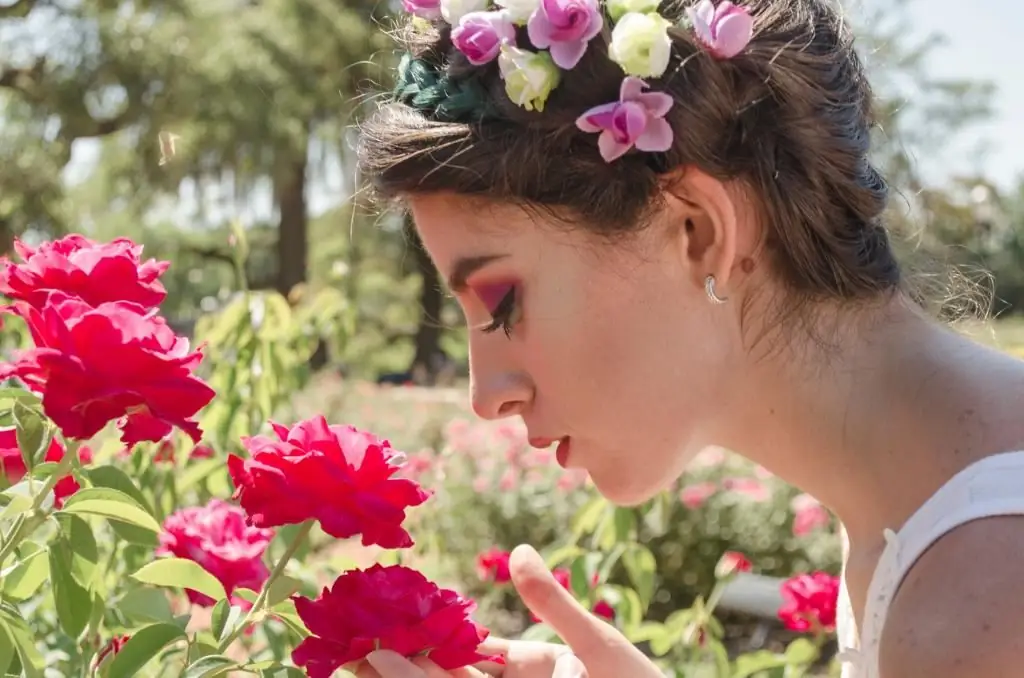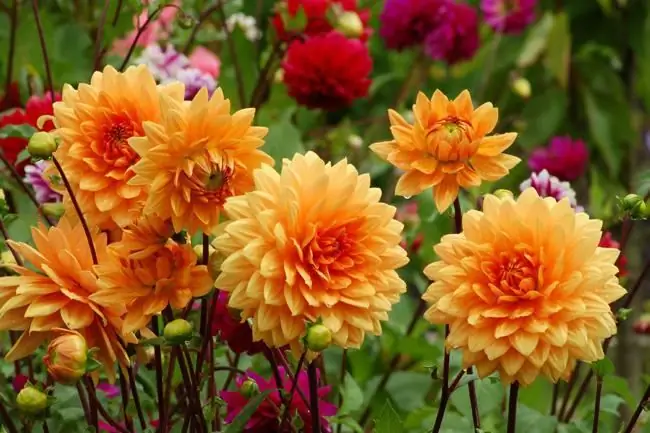- Author Henry Conors [email protected].
- Public 2024-02-12 02:46.
- Last modified 2025-01-23 09:07.
The description of the Corydalis flower can begin with the fact that this is one of the perennial plants with a very short growing season. It is a representative of a numerous genus of herbaceous plants of the Dymyankovye family. Sprouting in the still bare April forest, Corydalis is no longer found in mid-June. More than 200 species grow in the Himalayas and China. In general, the range covers the vast temperate latitudes of the Northern Hemisphere, and three varieties are considered the most common, including in our forests: dense, hollow and Marshall's Corydalis.

General characteristics of the species
The plant is a tuberous ephemeroid, therefore it is characterized by rapid germination, early fruit ripening and complete death of above-ground parts. A vital supply of nutrients accumulates in the tubers, due to which the vegetation resumes innext auspicious period of the year.
And now a general description of the flower. Corydalis differs both in appearance and in its structure. The plant is characterized by a low, fleshy stem 15 to 25 centimeters long and leaves that are twice or thrice dissected. The foliage is rich, and the inflorescences are located on top of it in bright, loose tassels. The sepals are almost invisible. Each individual Corydalis flower has an elongated base and consists of four small petals, with the ends of the upper and lower petals slightly turned outward. Each flower has one or two small leaves - a bract. In different places you can find yellow, pink, purple, blue, white Corydalis.

The Corydalis flower and varieties of this plant are excellent honey plants, in the spurs of which a lot of sweet nectar accumulates. True, only insects with long proboscises, such as bumblebees, manage to get it. The mature fruits of the plant are a dry box, shaped like a pod, in which seeds are formed. They are quite large, black, with a shiny surface and a juicy white seedling - a real delicacy of forest ants, which collect seeds and play a large role in the distribution of the species.
So why is Corydalis so interesting? Description, useful properties, the use of this perennial plant, we will consider further.
Description of the plant
Corydalis form lush bushes with numerous foliage, and during flowering, bright inflorescences rise like candlesover the green blanket. The tubers are a rounded root that has grown in width, in which peculiar holes-hollows form with age. Every year a young tuber is formed inside the old tuber, which turns into its shell.
External description of the flower: corydalis has a low stem with several light scale-like leaves at the base; densely green or bluish dissected foliage; brushes of flowers are located at the very tops of the stems; an irregular but graceful four-petalled flower, elongated.

If you look closely, you will notice that the two fused inner petals protrude slightly forward, like a spout, sticking out between the wrapped outer ones. The flowering period of Corydalis occurs at the end of April and the beginning of May, and by mid-June the flowers, stem and leaves die off completely.
Habitats of Corydalis
The favorite habitats of this plant are semi-shady areas of deciduous forests that do not have a dense canopy of grass and shrubs. The plant needs sunlight to start and go through the full cycle of vegetation, so corydalis make the most of the spring period, when the grass has not yet risen high, and forest trees have not bloomed their thick green foliage.

Features of vegetation
Tube corydalis ephemeroid (description of the plant, caring for it is of such interest to many) is developing quite quickly. It is spectacularthe decorative appearance of the plant attracts the attention of gardeners. Therefore, you should know the main features of its vegetation: after the seeds disperse and the aerial part dies off, only the Corydalis tuber, hidden deep in the ground, remains alive and awaits the onset of next spring; new life will be born from a large bud of renewal, which is formed at the top of the tuber and by March will approach the very surface of the soil, so that with the first warmth it will immediately give a young shoot.
Origin of the name
Everyone knows that Corydalis is a flower. The description for children, as well as for adults, is based on associations: the unusual shape of the flowers resembles a tuft of a bird, from where the name of the plant came from. Similar in meaning are the national names inherent in different peoples.
It is generally accepted that the scientific name of this genus comes from the ancient Greek word "koribalos", after the name of the crested lark. According to one of the old legends, the spring larks quarreled strongly among themselves and made a big fight. And the birds fought so fiercely that they tore each other's forelocks and spurs, which, having fallen on the forest ground, sprouted with beautiful Corydalis flowers.

Here you have a fabulous Corydalis flower. The description of why they called it that is also in German culture. There, the plant is called "lark's spur". There is also an ancient Slavic legend of the origin of the name of the flower. According to her, every night the old witch flew around the property on a broomstick, and at dawn she returned to her forest hut to sleep and rest. But hardlyshe had to doze off, as a cock greeted the dawn with a cry, not allowing the old woman to fall asleep. Then the angry witch turned him into a silent Corydalis flower. Because of this, other names for the plant are popular: “cockerels” or “chickens.”
Caring for Corydalis
Very unpretentious for breeding Corydalis plant. Description, reproduction, care for spectacular flowers will be considered using examples of those varieties that grow well in central Russia: hollow, smoke-leaved, Caucasian, Magadan, low, narrow-leaved, Marshall, Bush, Kuznetsov, etc. They decorate gardens, flower beds and flower beds.
Forest and Caucasian species, including dense corydalis, the description of which has much in common, are planted in the shade and partial shade of deciduous trees. Large tubers are usually buried to a depth of 10-15 centimeters, and small ones - to 5-7 centimeters. Corydalis love humus-rich, loose sandy loam (for forest species) and heavy clay (for Asian species) soils.
Asian species prefer well-lit hillocks, and in the case of wet summer, tubers can be dried during the dormant period (from mid-June) for a month.

Reproduction of Corydalis
Description of the Corydalis flower suggests familiarity with the characteristics of the reproduction of this plant. All transplant operations are carried out both during the rest period and at the very peak of flowering (the stem along with a clod of earth): in one case it is absolutely safe, although it is difficult to find small tubers in the ground, and in the other case it is convenient, since the shoots are clearly visible.
Corydalis is propagated by seed, although some species, such as Busha and Kashmiri, may form small side tubers. Seeds do not store for a long time, so they should be sown immediately after harvest. Flowering will come only in the 3-4th year.
Using corydalis
Bright multi-colored Corydalis look great on the alpine hills lined with stone, surrounded by crocuses, tulips, snowdrops, hostas. They are also an integral part of the colorful compositions of flower beds, park lawns and decorative flower beds.
Due to the high content of alkaloids, the plant is used in medicine and pharmacology. Preparations based on it relieve muscle tone, have a sedative effect on the nervous system, dilate blood vessels and lower blood pressure. And yet, different types of Corydalis are of the greatest interest as a decorative landscape gardening culture.






